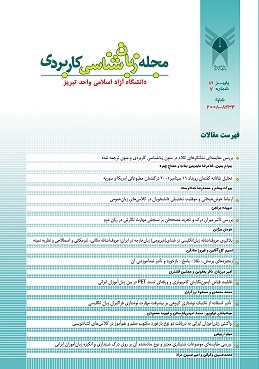IRF and ISRF Sequences and their Anti-Pedagogical Value
محورهای موضوعی : English Language Teaching (ELT)
امیر مرزبان
1
![]() ,
باقر یعقوبی
2
,
مجتبی قلندری
3
,
باقر یعقوبی
2
,
مجتبی قلندری
3
1 - Qaemshahr Branch, Islamic Azad University, Qaemshahr, Iran
2 - University of Mazandaran
3 -
کلید واژه: Classroom Interaction, Conversation Analysis Framework, IRF Sequences, ISRF Sequences,
چکیده مقاله :
Initiation, Response, and Feedback(IRF) sequences are the most frequent interaction network in any classroom contexts. IRF sequences have been examined profusely in previous studies and were reported to be negatively correlated with participation opportunities (Kasper, 2006; Cazden, 2001; Ellis, 1994).In all these studies, all contingent factors of any classroom context which might influence interaction network have been overlooked. Therefore, IRF sequences have been improvidently considered as static and inflexible interaction patterns which are unfolded invariantly in classroom. Based on video- taped data from ten English as a foreign language (EFL) classes, which were analyzed within conversation analysis framework, this study uncovered a modified version of IRF sequences labeled as ISRF (Initiation, Struggle, Response, and Feedback) sequences. Previous literature reported that IRF sequences offer very limited learning opportunities. ISRF sequences, on the other hand, have been shown in this study, to destroy even those very limited learning opportunities which IRF sequences could offer. The finding can both benefit teachers and teacher educators. It warns novice teachers to avoid applying this new interaction pattern in their classes and demands teacher educators to inform their trainees of the negative effect of ISRF sequences.
زنجیره های پرسش- پاسخ- بازخورد رایج ترین شبکه تعاملی در بافت کلاسی است. این زنجیره ها به صورت گسترده در مطالعات پیشین بررسی شدهاند و تاثیر منفی آنها در مشارکت کلاسی دانش آموزان مکرراً گزارش شده است (کاسپر2006، کزدن2001، الیس1994). در تمامی این مطالعات زنجیرههای پرسش- پاسخ- بازخورد عمدتاً به عنوان الگوهای تعاملی ثابت و غیرقابل انعطاف در نظر گرفته شدهاند. بر اساس داده های به دست آمده از ضبط ویدئویی از ده کلاس آموزش زبان انگلیسی به عنوان زبان خارجی که در قالب گفتگوکاوی تجزیه و تحلیل شدهاند ، این پژوهش گونه تغییر شکل یافته ای از این زنجیره تعاملی را مشاهده نمود که زنجیره پرسش- تقلا- پاسخ- بازخورد نامگذاری شده است . در این مطالعه نشان میدهیم که زنجیرههای پرسش-تقلا- پاسخ- بازخورد حتی فرصتهای محدود زنجیرههای پرسش- پاسخ- بازخورد را از بین میبرند. این کار پژوهشی به مدرسان زبان توصیه میکند که از استعمال زنجیرههای پرسش-تقلا- پاسخ- بازخورد در کلاس های خود خودداری کنند.
Barnes, D. (1969). Language in the secondary classroom.In D. Barnes, J. Britton & H. Roses (Eds.), Language, the learner, and the school (pp. 11-77).Harmondsworth, UK: Penguin.
Barnes, D. (1992). From communication to curriculum. Portsmouth, NH: Boynton/Cook.
Barnes, D. (2008).Exploratory Talk for Learning. Retrieved from: http://www.corwin.com/upm-data/23512_01_Mercer_Ch_01.pdf
Cazden, C. B. (1986). Classroom discourse. In Handbook of research on teaching (3rd ed., pp. 432–463). New York: Macmillan.
Cazden, C.B.(1988). Classroom discourse.The language of teaching and learning. Portsmouth, NH: Heinemann.
Cazden, C. (2001). Classroom discourse (2nd ed.). Portsmouth, NH: Heinemann.
Dinsmore, D. (1985). Waiting for Godot in the EFL classroom.ELT Journal, 3: 225-234.
Donato, R. (2000). Sociocultural contributions to understanding the foreign and second language classroom. In J. P. Lantolf (Ed.), Sociocultural theory and second language learning (pp. 27–50). New York: Oxford University Press.
Ellis, R. (1994). The Study of Second Language Acquisition. Oxford, England: Oxford University Press.
Gutierrez, K. (1994). How talk, context, and script shape contexts for learning: a cross case comparison of journal sharing .Linguistics and Education. 5, 335-365.
Hawkins, B. (2007). Open-endedness, the instructional conversation and the activity system: How might they come together? In R. Alanen& S. Poyhonen (Eds.), Language in action: Vygotsky and Leontievian legacy today (pp. 245–279). Cambridge: Cambridge Scholars Publishing
Hellermann, J, 2003. The interactive work of prosody in the IRF exchange: teacher repetition in feedback moves. Language in Society. 32, 79–104.
Kasper, G. (2006). Beyond repair: Conversation analysis as an approach to SLA.AILA Review, 19, 83–99.
Lin, A. (1999). Doing-English-Lessons in the reproduction or transformation of social worlds?TESOL Quarterly. 33(3): 393-412
Lemke, J. L. 1990.Talking science: Language, Learning and Values.Norwood, NJ: Ablex.
Mehan, H. (1979).Learning Lessons: social organisation in the classroom.Cambridge, MA: Harvard University Press.
Nassaji, H. & Wells, G. (2000). What’s the use of ‘triadic dialogue’? An investigation of teacher-learner interaction. Applied Linguistics, 21, 376– 406.
Nystrand, M. (1997). Dialogic instruction: When recitation becomes conversation. In M. Nystrand, A. Gamoran, R. Kachur, & C. Prendergast (Eds.), Opening dialogue: Understanding the dynamics of language and learning in the English classroom (pp. 1–29). New York: Teachers College Press.
Schegloff, E. A., & Sacks, H. (1974).Opening up closings.In R. Turner (Ed.) Ethnomethodology (pp. 233–264).Harmondsworth, UK: Penguin.
Seedhouse, P. (2004). The interactional architecture of the language classroom: A conversation analysis perspective. Malden, MA: Blackwell.
Sinclair, J. M., &Coulthard, M. (1975).Towards an analysis of discourse: The English used by teachers and pupils. London: Oxford University Press.
Ten Have, P. (1999). Doing Conversation Analysis: A practical Guide. London: SAGE Publications.
Waring, H. Z. (2008).Using explicit positive assessment in the language classroom: IRF, feedback, and learning opportunities.Modern Language Journal, 92, 577–594.
Waring, H. Z. (2009).Moving out of IRF: A single case analysis. Language Learning, 59(4), 796-824.
Wood, D., Bruner, J., & Ross, G. (1976).The Role of Tutoring In Problem Solving.Journal of Child Psychology and Psychiatry, 17: 89-100.


